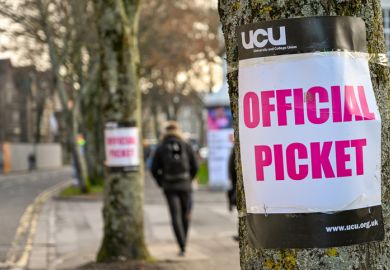Union elections at Amazon warehouses and Starbucks coffee houses have grabbed big headlines in the US this year, but a new battle for unionisation is quietly gaining ground in an unexpected place: the nation’s colleges.
Fuelled by the Covid-19 pandemic and vacillating decisions by the National Labor Relations Board (NLRB), student workers have begun seeking union representation in growing numbers. This wave of unionising that began with undergraduate students has now swept up graduate students as well.
In 2016, the NLRB announced that teaching and research assistants at Columbia University would be categorised as employees and entitled to collective bargaining rights under the National Labor Relations Act. This decision reversed the board’s prior holding for Brown University, which excluded graduate students from the category of employee and denied the group any collective bargaining rights.
The Columbia University decision was considered a historic win for student assistants and marked the end of a long battle that began in late 2013, when the GWC-UAW Local 2110 Union (now known as Student Workers of Columbia) began organising and campaigning for collective representation of both undergraduates and postgraduates.
The first solely undergraduate push for unionisation started at Iowa’s Grinnell College in 2016. Student workers established a union for dining hall workers, benefiting from an NLRB rule that permitted private college undergrads to unionise. An effort to widen the union for all student workers met resistance during the Trump administration, due in part to a series of back-and-forth decisions by the NLRB over the decades about whether students can be classified as employees.
This April, the NLRB elected to allow the expansion at Grinnell. This opened the remaining floodgates.
Wesleyan University in Connecticut became the first confirmed union of undergraduate student workers at a private college to be voluntarily recognised. The union push came in response to the difficulties of working during the pandemic, as student employees dealt with staff losses, Covid protocol enforcement and denial of hazard pay – all while being forced to stay on campus while other students went home to escape the illness.
Emboldened by their success, Wesleyan organisers went on the road, training student workers at other schools to follow their lead. This spring, Dartmouth dining workers voted to unionise, as did resident assistants at Wesleyan.
One recent example is Ohio’s Kenyon College, where resident advisers went on strike in April after the school announced changes to their pay and denied them voluntary recognition as a union. Other student workers – from those at the campus bookstore and writing centre to the college’s farm and career development office – joined the strike in May. At that time, about 300 student workers had signed union cards.
The result, at Kenyon College and elsewhere, is a new dynamic that will require a considerable adjustment by colleges. But, for now, most aren’t making a course change.
Instead, many have argued that unions disrupt their primary relationship with the students – one that is educational and not labour-related. The uniformity that unions often impose on the employees they represent may also conflict with the flexibility required to complete educational programmes, they argue.
Kenyon College, for example, issued a statement acknowledging the importance of unions in some workplaces but declaring that the model does not fit its undergraduate academic setting. Kenyon also noted that by recognising a union, the college would be effectively tying a future generation of students to union representation without their having a say in it.
Another concern for colleges is the potential for higher costs. For example, student employees often have a limit to how many hours they can work in a week. If a union wanted to further limit these hours, the university would need to hire more student employees.
But while the summer break cooled union efforts, more private colleges should expect unionisation movements. So what can they do to prepare?
First, they should become knowledgeable about all things union. That means getting up to speed on the NLRB and its role in union votes, representation and complaints. In particular, they should understand the unionisation process, which is overseen by the NLRB and governed by its own set of rules about what employers can do, such as voice opinions about the union and point out costs of the union.
The NLRB also indicates strict rules about what employers cannot do and what indicates an unfair labour practice. These rules also set the thresholds for what is required to bring a vote, and how many votes are needed within the organising group to trigger union recognition.
It also is important for colleges to remember that while both parties are obliged to meet at regular intervals and confer in good faith, they are not forced to agree on any terms.
For now, the undergraduate unionisation movement is confined to private colleges. Public universities have yet to contend with union chants and picket signs, largely because they are governed by their state personnel boards of review (or SERBs) and generally follow state law rather than policy set by the NLRB.
However, they should keep this in mind: NLRB precedent is generally followed by SERBs.
Jeffrey Stankunas is chair of the labour and employment law practice at Columbus law firm Isaac Wiles. Emily Dilloway is a law clerk at Isaac Wiles and a third-year law student at Capital University Law School.
Register to continue
Why register?
- Registration is free and only takes a moment
- Once registered, you can read 3 articles a month
- Sign up for our newsletter
Subscribe
Or subscribe for unlimited access to:
- Unlimited access to news, views, insights & reviews
- Digital editions
- Digital access to THE’s university and college rankings analysis
Already registered or a current subscriber?








